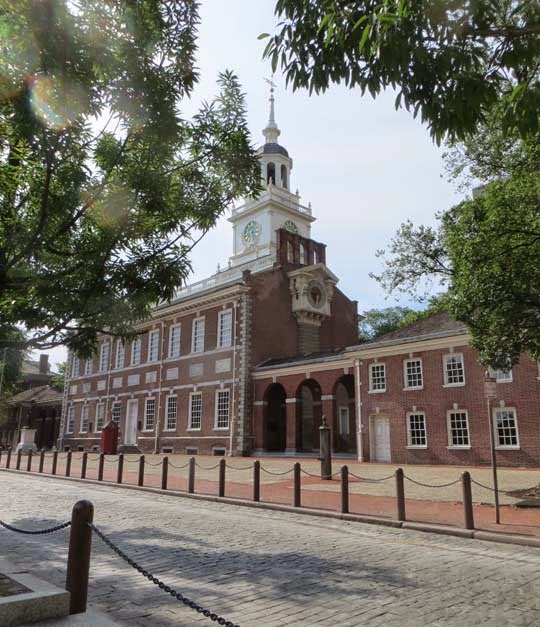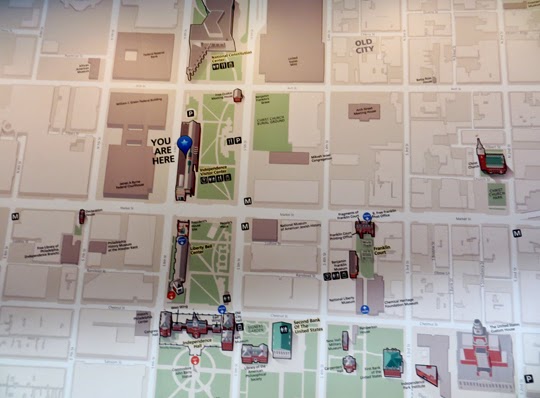 |
| The Liberty Bell, cast in 1753 by John Pass and John Stow for the Pennsylvania State House |
The Liberty Bell, with its famous crack, has long been a symbol of the American Revolution. But contrary to popular belief, there is no evidence that the Liberty Bell rang on July 4, 1776, to proclaim independence. However, it did ring on many other occasions and was used to summon members of the Pennsylvania Assembly and to announce noteworthy events. It last rang in 1846 to celebrate the birthday of George Washington.
 |
| Independence Hall |
Two weeks ago Art and I spent the weekend in Philadelphia at a family celebration and had the opportunity to visit the Liberty Bell and other sites around Independence Mall. The wealth of historic sites reminded me how central Philadelphia was to the early history of the United States. A map inside the
Liberty Bell Center shows dozens of important sites–Independence Hall, the Benjamin Franklin Museum, Betsy Ross’ House, Christ Church and the Christ Church Burial Ground, Mikvah Israel Congregation (the oldest continuous synagogue in the United States), the Franklin Mint, the new National Constitution Center, to name a few. We visited the historic area on a Sunday morning, which had the advantage of being cooler and less crowded.
 |
| Part of historic Philadelphia |
My last visit to Philadelphia was fifteen years ago and I remember going inside Independence Hall and seeing where the Continental Congress first met. Now, in order to go inside, one has to get a ticket (which is free) and stand in line for a tour (which we didn’t do because of our limited time, although we did walk through the grounds.) On my last visit, the Liberty Bell was housed in a small building by itself. Now it is part of a large visitor center filled with exhibits about the bell and the concept of freedom, focusing on the fight to end slavery and for equal rights for all citizens of the United States.
 |
| Exhibits in the Liberty Bell visitor center |
If you go to Philadelphia, it’s hard to avoid Benjamin Franklin. You can see where he lived, where he worked, and where he is buried. His name is everywhere from the Franklin Mint to Franklin Court behind the Ben Franklin Museum. Even the chairs in the lobby at the Westin Hotel where we stayed were decorated with his image.
 |
| Coins for good luck are strewn across Benjamin Franklin's Grave |
Born in 1706 in Boston, Benjamin Franklin moved to Philadelphia as a young man, where he lived until is death in 1790 at the age of 84. Among his many accomplishments are that he founded the Philadelphia Library, invented the Franklin stove, was the first to utilize electricity, was the postmaster of Philadelphia, and a delegate to the Continental Congress. At his grave site in the Christ Church Cemetery there are two plaques. One lists important dates in his long life. The other has three quotes about him. My favorite is by French writer Anne-Robert-Jacques Turgot who wrote: “He tore from the skies the lightning and from tyrants the scepter.” (1779)
This trip made me realize that I need to go back to Philadelphia when I have more time so I can do justice to all the fascinating history in the city.
 |
| Plaque at Christ Church Cemetery with famous quotes about Benjamin Franklin |






















